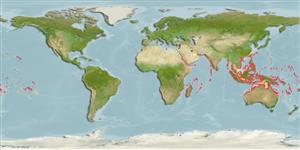Common names from other countries
Environment: milieu / climate zone / depth range / distribution range
Ecologie
Rifbewoner; standvastig (Ref. 348); brakwater; diepteverspreiding 0 - 35 m (Ref. 348). Tropical; 23°C - 30°C (Ref. 102835); 28°N - 37°S, 31°E - 128°W
Indo-Pacific: Egypt to Pitcairn Islands and Ogasawara, Japan to Lord Howe Island.
Length at first maturity / Size / Gewicht / Leeftijd
Maturity: Lm ?, range 6 - 13 cm Max length : 41.7 cm SHL mannelijk/geslacht niet bekend; (Ref. 117184); common length : 25.0 cm SHL mannelijk/geslacht niet bekend; (Ref. 348)
The mantle color is highly variable, ranging from bright blue to brown.
Collected for food and for the shell trade. Aquaculture trials have been done in 1998 (Ref. 348). Maximum depth from Ref. 75831. Found in coral reef flats in shallow areas (Ref. 799), reef areas of lagoons (Ref. 97298) and in intertidal areas (Ref. 75831). Mixotrophic - filter feeds and photosynthesizes via its zooxanthellae (Ref. 105208). Tridacnids derive their nutrition from uptake of dissolved matter through their epidermis and from their symbiotic zooanthella Symbiodinium microadriaticum (Ref. 107098).
Life cycle and mating behavior
Geslachtsrijpheid | Voortplanting | Kuitschieten | Eieren | Fecundity | Larven
Life cycle: Embryos develop into free-swimming trocophore larvae, succeeded by the bivalve veliger, resembling a miniature clam (Ref. 833).
SAUP Database. 2006. (Ref. 356)
Status op de Rode Lijst van het IUCN (Ref. 130435)
Status bij CITES (Ref. 108899)
Not Evaluated
Gevaarlijk voor mensen
Reports of ciguatera poisoning (Ref. 130160)
Gebruik door de mens
Visserij: commercieel
FAO - Aquacultuur: production; | FishSource | Sea Around Us
Tools
Internet-bronnen
Estimates based on models
Preferred temperature
(Ref.
115969): 24.8 - 29.3, mean 28.4 (based on 3421 cells).
Weerstandsvermogen
Gemiddeld, minimale populatieverdubbelingstijd 1,4-4,4 jaar (K=0.18-0.28; tm=3.8).
Prior r = 0.49, 95% CL = 0.32 - 0.73, Based on 1 data-limited stock assessment.
Kwetsbaarheid
Low vulnerability (25 of 100).
Prijsklasse
Unknown.
